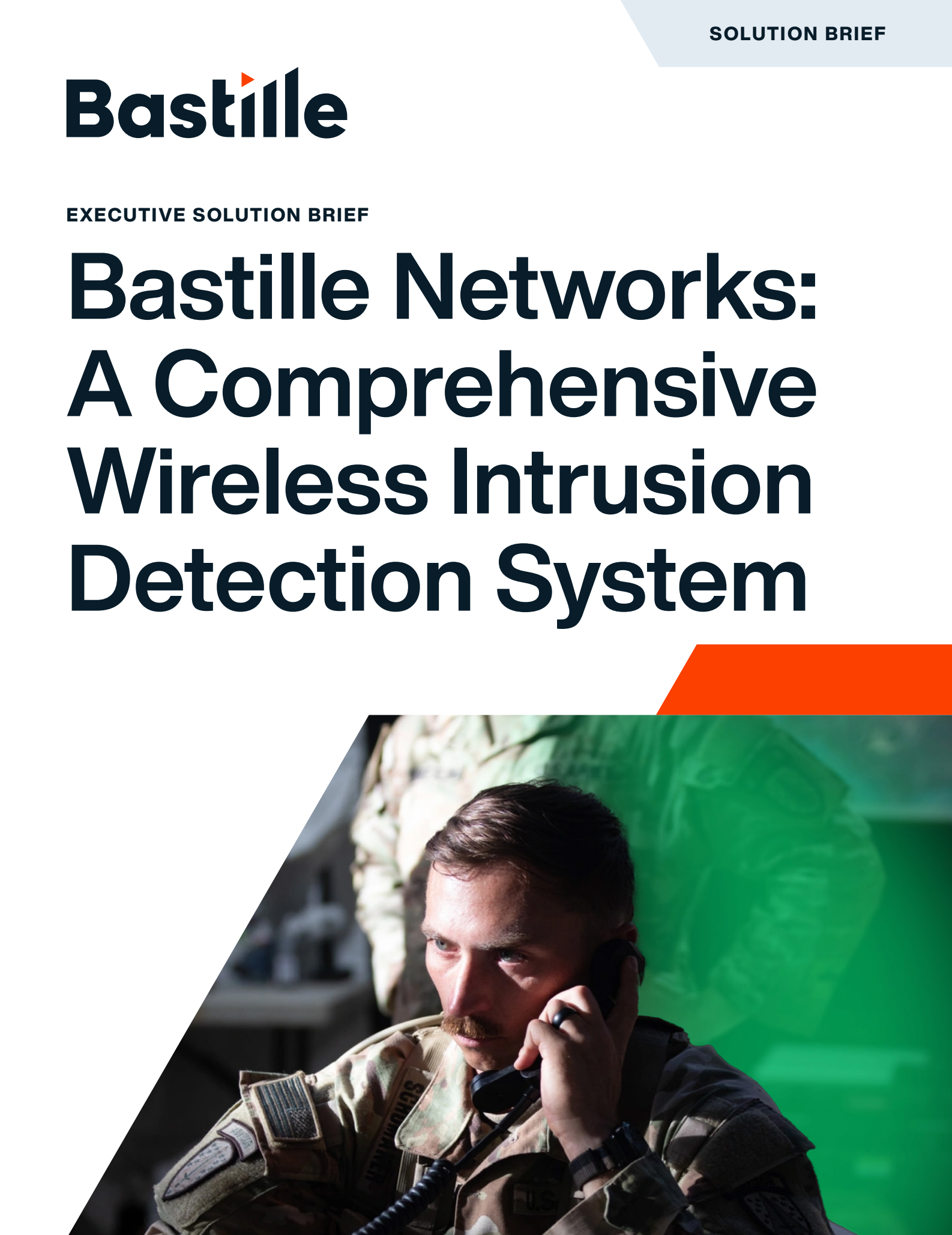
The Growing Threat of Wireless Attacks
Modern cybersecurity strategies must account for threats that extend beyond networks and endpoints. Organizations adopting wireless technologies to enhance mobility create a new, often invisible, attack surface: the surrounding airspace.
Wireless Intrusion Detection Systems (WIDS) have emerged to fill a critical gap in security postures. These systems help detect unauthorized wireless activity and support enforcing wireless security policies. In environments where mission assurance is vital, such as defense, intelligence, or critical infrastructure, WIDS is an essential component of layered defense. However, the wireless threat landscape extends beyond Wi-Fi, including cellular, IoT, and Bluetooth, and WIDS solutions have evolved to address these threat vectors.
What Makes Wireless Threats So Dangerous?
Wireless threats differ fundamentally from traditional cyberattacks. They do not require network credentials or physical connections to penetrate systems. Instead, they exploit proximity and the open nature of radio frequency communication.
Attackers may operate outside a building, launching attacks from nearby vehicles, lobbies, or adjacent offices. Traditional tools such as firewalls, endpoint protection, and network intrusion detection systems lack visibility into radio frequency (RF) activity, leaving a significant portion of the attack surface unmonitored.
The widespread use of personal mobile devices, IoT sensors, and embedded systems, all emitting wireless signals, compounds the issue. Without active monitoring of these transmissions, many threats can operate undetected.
WIDS vs. Traditional Security Tools
Traditional security tools can’t monitor radio frequency activity. Firewalls manage network perimeter traffic, intrusion prevention systems examine packet behavior, and endpoint tools monitor user activity. However, none of these technologies detect wireless signals that bypass the wired or IP network.
WIDS closes part of that gap. These systems monitor the 2.4 and 5 GHz spectrum for unauthorized access points, spoofed SSIDs, and rogue client devices. They also help identify attacks such as deauthentication floods or impersonation attempts.
WIDS provides coverage within the 802.11 standard. As the wireless threat landscape has evolved, WIDS has kept pace with detecting threats operating on wireless protocols such as Bluetooth, BLE, Zigbee, or cellular.
Understanding How WIDS Detects Intrusions
WIDS operates by passively scanning wireless channels for anomalies or policy violations. The system uses sensors throughout a facility to monitor wireless traffic and compares real-time activity to authorized device lists, configurations, and expected behavior patterns.
These systems may detect:
- Rogue or spoofed access points broadcasting unauthorized SSIDs
- Devices transmitting from suspicious or unexpected locations
- Changes in wireless beacon intervals or signal characteristics
- Unusual MAC address activity or impersonation attempts
In response, the WIDS platform generates alerts and logs data for analysis, providing security teams visibility into wireless threats
Common Wireless Attack Vectors in Government Facilities
Facilities handling sensitive or classified information face wireless threats. Examples of these threats include:
- Evil Twin Attacks: Malicious access points mimic authorized SSIDs to trick users into connecting to them, capturing credentials or traffic.
- Bluetooth Skimming: Wireless tools capture keystrokes or voice data from headsets, keyboards, or wearables.
- Zigbee Injection: Adversaries manipulate smart infrastructure, such as lighting or HVAC systems, to extract information or cause disruption.
- RF Jamming: Attackers flood frequency bands with noise to disrupt wireless communication or create operational confusion.
- Hidden BLE Beacons: Hidden transmitters surreptitiously record audio or location data while evading detection.
These threats bypass traditional detection systems entirely.
Why WIDS Should Be the First Line of Defense
Wireless threats often strike before traditional controls are engaged. WIDS allows security teams to observe wireless activity at a facility’s perimeter, acting as a sensor layer for the invisible RF domain.
WIDS systems contribute by:
- Detecting wireless threats before network compromise occurs
- Identifying the physical location of unauthorized devices
- Reinforcing policies prohibiting wireless use in restricted zones
- Serving as a visual deterrent for actors aware of wireless monitoring
Such systems support early-warning functionality and improve organizational posture against low-complexity wireless threats.
Real-Time Protection for SCIFs, DoD Sites, and Federal Agencies
Sensitive Compartmented Information Facilities (SCIFs), defense contractors, and government agencies often maintain wireless-free policies. However, enforcing such policies requires active detection of unauthorized emissions.
WIDS supports this requirement by identifying active or broadcasting wireless devices within defined zones. These detections may include unauthorized smartphones, personal hotspots, or rogue laptops that violate wireless restrictions.
WIDS can integrate into existing security operations workflows, complementing badge-based access control and physical sweeps by offering continuous surveillance of wireless transmissions.
The ROI of Early Detection and Prevention
Wireless attacks can result in operational disruption, regulatory penalties, and the loss of sensitive information. The costs of reactive incident response far exceed the investment in proactive monitoring tools.
WIDS provides value by
- Reducing time to detection
- Preventing operational delays caused by unauthorized wireless activity
- Supporting compliance with federal and agency-specific wireless control requirements
- Mitigating the impact of policy violations through rapid alerting
Nonetheless, organizations relying solely on WIDS may not realize complete risk mitigation due to its limited detection scope.
WIDS and Zero Trust: Extending Security to the Airspace
Zero-trust architectures emphasize continuous verification of every device, user, and signal. However, wireless airspace remains a frequently unmonitored vector.
WIDS extends Zero Trust into the wireless domain by verifying known access points, detecting rogue transmissions, and logging wireless activity. A comprehensive Zero-Trust model requires visibility across all attack surfaces. Without coverage into the RF spectrum, a significant portion of the physical layer attack surface remains exposed.
Expanded Protection with Bastille’s RF Visibility Platform
Bastille offers a software-defined platform that expands wireless monitoring beyond other security solutions. Bastille’s solution provides full-spectrum RF visibility from 100 MHz to 7.125 GHz, enabling detection across protocols such as Bluetooth, Zigbee, BLE, Cellular, and others.
Core Capabilities
- 100% passive RF monitoring across all major wireless protocols
- Localization of unauthorized or suspicious emitters
- Real-time visualization of RF activity via heat maps and zoning
- Historical replay for compliance audits and forensic investigations
- RF fingerprinting for identifying repeat offenders or known devices
Operational Deployments
Bastille’s platform has deployed to:
- SCIFs requiring 24/7 RF monitoring
- Defense contractor test and logistics sites
- Federal agency campuses
- High-security R\&D environments
Zero Trust Integration
Bastille’s platform extends Zero Trust security to the RF domain. The system enhances threat prevention by validating all RF activity within defined zones and identifying anomalies in real time without interfering with existing network infrastructure.
Case Insight: Stopping an Attack Before It Started
The Bastille platform detected an anomalous BLE signal during a scheduled wireless security audit at a secure government facility. The signal originated from a personal fitness tracker brought into the building, which violated policy.
Although the BLE transmission did not interact with the corporate network, an unauthorized emitter within a classified space constituted a serious policy breach.
Traditional WIDS would not have identified this signal. This incident illustrates the limitations of Wi-Fi-only monitoring and highlights the growing need for protocol-agnostic RF detection platforms.
Conclusion: Closing the Gaps in Wireless Security
As wireless technologies proliferate across enterprise and government environments, organizations face a growing array of threats operating beyond the boundaries of traditional detection tools. WIDS provides a critical but narrow window into this threat landscape, offering essential monitoring of 802.11-based activity and supporting compliance in wireless-restricted zones.
However, advanced threats increasingly rely on non-Wi-Fi protocols. To close this visibility gap, organizations must adopt full-spectrum RF monitoring capabilities.
Bastille delivers that expanded coverage. By offering 100% passive monitoring across the full RF spectrum, Bastille equips organizations with the tools to identify, locate, and respond to all wireless threats, regardless of protocol. From SCIFs to defense campuses and critical infrastructure sites, Bastille enables airspace awareness as part of a Zero-Trust strategy.
Bastille transforms wireless from a vulnerability into a controllable, auditable asset, helping organizations secure what they cannot see.
Frequently Asked Questions About WIDS and Wireless Threats
What is a Wireless Intrusion Detection System (WIDS)?
A WIDS is a passive solution that monitors wireless channels to detect unauthorized activity. It supports policy enforcement and intrusion response by identifying rogue devices and anomalous behaviors.
Can WIDS detect non-networked devices?
WIDS can detect wireless-capable devices even if those devices do not connect to a network.
Is WIDS useful for classified environments like SCIFs?
Yes. WIDS supports compliance with wireless-free mandates by detecting unauthorized RF signals within secure facilities.
How does a WIDS locate threats?
WIDS uses several approaches to approximate the location of devices broadcasting within its monitored range. However, not all WIDS solutions can accurately locate wireless devices in a space.
Is WIDS sufficient for modern wireless security?
WIDS is a foundational component of wireless defense. Environments with elevated risk profiles should consider a broad-spectrum RF-monitoring WIDS solution.



